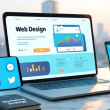Introduction to Digital Twin Technology
Digital twin technology represents a groundbreaking development in the ability to digitally replicate physical entities or processes. A digital twin is a dynamic virtual representation that mimics the real-time state, condition, and behavior of a physical object, system, or process. The concept first emerged in 2002, introduced by Dr. Michael Grieves, and has since grown to become an essential tool across a variety of industries. Its evolution has been driven by advances in the Internet of Things (IoT), Artificial Intelligence (AI), machine learning, and extended reality (XR), among others. The technology is now being applied to optimize operations, improve sustainability, and facilitate innovation.
1. Expansion Beyond Industrial Applications

While digital twins were initially used predominantly in industries like aerospace, manufacturing, and automotive, the technology has expanded to a diverse range of sectors including healthcare, retail, and construction. By creating virtual representations of physical systems, organizations can model, analyze, and optimize their operations in ways that were previously impossible.
Healthcare has embraced digital twins to enhance patient care. By creating personalized models based on real-time health data, digital twins can help doctors make more accurate diagnoses and design individualized treatment plans. Similarly, retail companies are using digital twins to optimize store layouts, inventory management, and customer experience.
Example:
A prominent application of digital twin technology in construction is the simulation of entire buildings throughout their lifecycle. A building’s HVAC system, for instance, can be modeled and tested in a digital environment to predict energy consumption, identify inefficiencies, and reduce operational costs.
Case Study:
Siemens has implemented digital twins in manufacturing plants to optimize production workflows and reduce unplanned downtimes. By simulating production lines, Siemens can detect potential issues in real-time and take corrective action before problems arise, ultimately enhancing operational efficiency.
2. IoT and 5G Integration
The convergence of digital twins with IoT (Internet of Things) and 5G technology has been a pivotal advancement. IoT devices, embedded with sensors, collect vast amounts of real-time data from physical assets. This data is then sent to the digital twin, allowing for constant updates and continuous monitoring. 5G networks play a crucial role in enhancing the capabilities of digital twins by enabling fast and low-latency data transmission.
In sectors such as energy, for example, digital twins of wind turbines can predict when maintenance is needed by collecting data from IoT sensors. This predictive maintenance approach minimizes downtime, improves performance, and reduces unexpected repair costs.
Example:
Smart cities use digital twins combined with IoT and 5G to monitor urban infrastructure in real time. This enables city planners to manage resources more effectively and optimize services like waste management, traffic control, and energy distribution.
Case Study:
Wind turbine operator Ørsted uses digital twins and IoT sensors to monitor the health of turbines. The data collected helps the company predict potential failures and reduce maintenance costs by addressing issues proactively.
3. AI-Powered Digital Twins
The integration of AI and machine learning with digital twins adds an extra layer of sophistication, enabling predictive analytics, optimization, and automated decision-making. AI-driven digital twins can simulate various scenarios, predict potential failures, and recommend actions to improve performance or efficiency.
For instance, in manufacturing, AI-enhanced digital twins can analyze real-time data from production lines to optimize scheduling, inventory management, and maintenance cycles. This leads to reduced costs, fewer disruptions, and improved overall efficiency.
Example:
In the automotive industry, digital twins powered by AI are used to simulate vehicle performance under various environmental conditions, predicting potential issues and optimizing designs before physical prototypes are made.
Case Study:
General Electric (GE) has successfully employed AI and digital twins in their jet engine division. Using sensor data from engines, AI models predict maintenance needs, reducing downtime and saving costs for airlines.
4. Sustainability Focus

As organizations increasingly focus on sustainability, digital twins offer significant opportunities to reduce environmental impacts. The technology allows for the simulation and optimization of energy consumption, waste management, and resource use, making it easier for companies to meet their sustainability goals.
In construction, for instance, digital twins can help design energy-efficient buildings by modeling energy usage patterns and optimizing HVAC systems. In manufacturing, digital twins allow companies to identify inefficiencies in production and reduce waste.
Example:
Smart cities use digital twins to simulate the impact of urban infrastructure on the environment. This enables city planners to make more sustainable decisions regarding transportation, energy distribution, and waste management.
Case Study:
Singapore uses a digital twin of the entire city to optimize energy use and reduce waste. The model tracks traffic patterns, weather conditions, and energy consumption to help authorities improve the sustainability of urban infrastructure.
5. Blockchain for Security and Data Integrity
The integration of blockchain technology with digital twins is enhancing data security and ensuring the integrity of information. Blockchain’s decentralized and immutable ledger system allows for secure, transparent, and verifiable tracking of the data flows between digital twins and physical assets.
Example:
In supply chains, digital twins combined with blockchain can track the movement of goods from origin to destination, ensuring data integrity, reducing fraud, and improving transparency.
Case Study:
IBM’s Food Trust blockchain is a prime example of how digital twins and blockchain work together to enhance transparency in the food industry. By using digital twins to track food products and blockchain to verify each transaction, businesses can ensure food safety and reduce waste.
6. Extended Reality (XR) and Digital Twins
The integration of Extended Reality (XR), which includes Augmented Reality (AR) and Virtual Reality (VR), with digital twins provides immersive and interactive experiences. XR technologies enable users to interact with digital twins in real-time, enhancing everything from design and maintenance to training and optimization.
In automotive manufacturing, engineers can use XR to interact with 3D models of vehicles, improving design accuracy and reducing prototyping costs. In maintenance, technicians can use AR glasses to receive real-time information about systems, improving troubleshooting and reducing downtime.
Case Study:
Boeing uses XR and digital twins for technician training. By simulating aircraft maintenance procedures in a virtual environment, Boeing enhances employee skill development, reducing training time and ensuring higher operational efficiency.
7. Standardization and Interoperability
For digital twin technology to scale, standardization and interoperability are essential. By establishing universal standards, businesses can ensure that digital twins across different sectors and platforms can communicate with one another. This reduces complexity and streamlines the implementation of digital twins across various systems.
Example:
In manufacturing, standardizing the data formats used by digital twins ensures seamless integration between different machines and systems, reducing integration challenges and improving operational efficiency.
Case Study:
The Industrial Internet Consortium (IIC) has been instrumental in developing standards for digital twin technology, helping to create a framework for interoperability across various industries. This has played a critical role in accelerating the adoption of digital twins in industrial applications.
8. Scalability and Implementation Roadmap

Successfully implementing digital twins requires careful planning, starting with small-scale pilot projects before scaling up. By evaluating the performance and outcomes of these pilot projects, organizations can refine their approach and gradually expand the use of digital twins across larger systems.
Example:
A manufacturing company may begin by implementing a digital twin for a single machine or production line. As the technology proves its value, it can be expanded to other parts of the facility, eventually creating a digital twin of the entire production process.
Case Study:
Rolls-Royce initially introduced digital twins for a small fleet of jet engines, allowing the company to optimize maintenance schedules and reduce downtime. Over time, this system was expanded to cover a broader range of engines, resulting in significant cost savings and efficiency gains.
9. Future Potential and Emerging Trends
Looking ahead, digital twin technology holds immense potential, particularly as new technologies like 5G, edge computing, and quantum computing come to the forefront. These technologies will enable even more sophisticated digital twins capable of simulating complex environments in real time.
In autonomous vehicles, for instance, digital twins could be used to simulate the behavior of vehicles and their surroundings in real time, allowing for safer and more efficient transportation. In smart cities, digital twins will continue to evolve, providing deeper insights into urban systems and enabling better decision-making.
Example:
The automotive industry is exploring the use of digital twins in autonomous vehicles. Real-time data from the vehicle’s sensors would feed into a digital twin of the surrounding environment, allowing the vehicle to make split-second decisions based on simulations.
Case Study:
New York City has begun experimenting with digital twins to optimize urban planning, traffic management, and sustainability. By creating a digital model of the city, officials can simulate the impact of different interventions on traffic patterns, energy usage, and overall urban efficiency.
Conclusion
Digital twin technology has evolved from a tool used primarily in industrial sectors to a versatile solution with applications across many industries, including healthcare, smart cities, and manufacturing. With the integration of IoT, AI, blockchain, and XR technologies, digital twins are becoming more powerful and capable of providing real-time insights, predictive maintenance, and operational optimization. As the technology continues to advance, its impact on sustainability, cost reduction, and operational efficiency will only grow, positioning digital twins as a critical component in the future of industry and urban planning.












